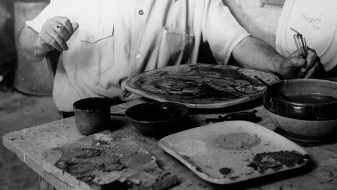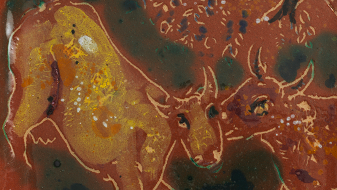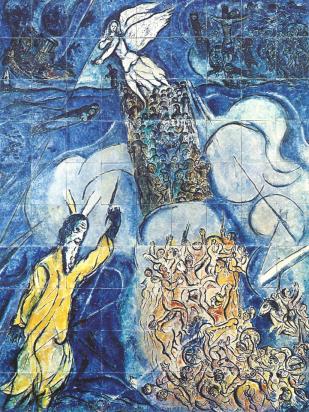Chagall had the idea for the Crossing of the Red Sea ceramic mural after his friend, philosopher Jacques Maritain, introduced him to Father Alain-Marie Couturier during their New York exile. In a 1967 letter, the artist recalled the meeting’s decisive role: "I took on the stained-glass window project for him [Father Couturier] and because of him. In New York, he asked me to make something for the Plateau d'Assy chapel, a wartime project. ... That is how I came to make my first two stained-glass windows, a large ceramic piece (The Crossing of the Red Sea) and two bas-reliefs for the Plateau d'Assy.”1 Made at the Madoura studio in 1956 and mounted in 1957, the 90-tile mural ceramic was Chagall's first monumental work in a group of projects for the baptistery of the Notre-Dame-de-Toute-Grâce chapel in Assy.
Canon Jean Devémy asked Savoyard architect Maurice Novarina to design the Plateau d'Assy Catholic church, which was built between 1937 and 1946. A symbol of the sacred art revival in France, it became famous for works by some of the 20th century's leading figures: Jean Bazaine, Pierre Bonnard, Georges Braque, Odette Ducarre, Fernand Léger, Jacques Lipchitz, Jean Lurçat, Henri Matisse, Germaine Richier, Georges Rouault, Théodore Stravinsky, and others made stained glass windows, ceramics, mosaics, tapestries, paintings, sculptures, furnishings and liturgical objects. "The church on the Plateau d'Assy will go down in history as a crossroads for contemporary experimentation," wrote Father Couturier. "It was only natural to ask Chagall to participate2.”
Canon Devémy, who had a well-known passion for the Red Sea story, suggested the subject to Chagall: "You will quickly understand that the Crossing of the Red Sea is the capital fact: the cloud that accompanied the people led by Moses, which shined at night, was the very presence of God. I am sure that this theme will inspire you3.” This Biblical motif from the Old Testament book of Exodus tells the story of Moses leading the Israelites out of bondage in Egypt and into freedom in the Promised Land.
The first time Chagall addressed the Red Sea theme was in a 1931 preparatory study for the Bible commissioned by Ambroise Vollard. Chagall returned to the theme in the early 1950s, when he began designing his monumental series of Biblical Message paintings. The motif appeared in ceramic on a plate from 1951 before it was featured several times in enamel and oxides on lava stone plaques, small ceramic tiles and studies on canvas and paper. Unlike the more narrative, descriptive 1930s versions, the 1950s experiments focused on the architectural dimension of composition, which could be transposed from the smallest formats to monumental ones. The new composition is based on lines of construction: the horizon line at the apex of a triangle made up of a crowd splitting the sea, the slender figure of Moses and an angel above the horizon. The distribution of colored masses and the more abstract treatment of bodies and clouds add to the work’s monumentality. Through multiple versions with fine variations, Chagall sought to create tension between iconographic features and material effects as well as a very specific presence of characters from one version to the next. Bearing a dedication in the lower left, "in the name of all religions", The Crossing of the Red Sea was a gift from the artist to the Assy church in memory of Father Couturier and "in the name of peace and tolerance among all men.”4 Chagall’s only ceramic work in a public space, it foreshadows, through his reflections on light, the many stained-glass windows he later created.
Ceramic
The Crossing of the Red Sea, Notre-Dame-de-Toute-Grâce, Plateau d'Assy
(La Traversée de la mer Rouge, Notre-Dame-de-Toute-Grâce, le plateau d'Assy)
Keyword:


